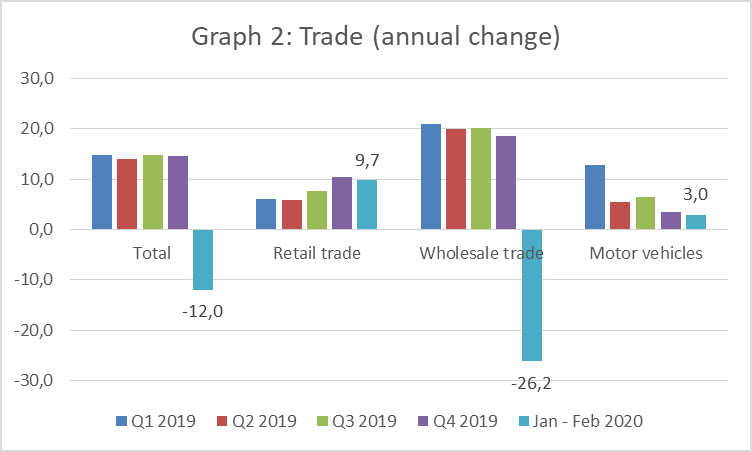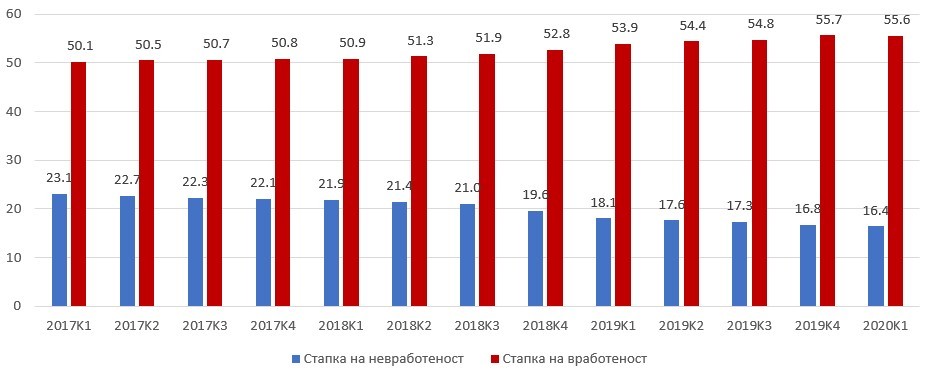Quarterly Economic Monitor – Projections Q1 – 2020
Analysis and publications
Macedonia 2025 forecast: GDP growth in Q1 2020 will be between 2.0% and 4.0%
According to the latest high frequency indicators and available data, moderate deceleration of the economic growth is expected in Q1 2020, compared to the previous quarter.
The projection is due to the following economic developments in Q1 2020:
Production side:
Industrial production: After the decline in the last quarter of 2019, industrial production registered sluggish growth of 1.9% in the first two months of 2020.
This development represents a positive impulse for GDP growth in the analyzed period. A more detailed analysis indicates that the low growth is mostly due to the decline in the utilities sector, while the mining sector and processing industry recorded a solid growth (8.6% and 5.6% respectively). The risks in industrial production are increasing bearing in mind the deceleration of the global economy, especially the slowing down of the economy of our biggest trading partner – Germany.
Higher decrease in industrial production is expected in the third month of 2020.
The data for industrial production indicate that the industry will have a moderate positive contribution to GDP growth in Q1 2020.
Graph 1: Industrial Production (Annual Growth Rate)

Source: State Statistical Office of the Republic of Macedonia
Trade: As can be seen in Graph 2, the high growth rates of the previous period do not continue into the first quarter of 2020. Total trade fell by 12% between January and February 2020, the decline resulting from a sharp decrease in wholesale trade. At the same time, retail trade recorded a solid growth rate, while the growth rate of motor vehicle trade increased modestly by 3%. Retail trade is currently in line with budget data, which shows a higher inflow of value-added tax (VAT) collection. However, having in mind that the impact of the Covid-19 crisis on the Macedonian economy accelerated in March, further deterioration and higher decline is expected in the trade sector in Q1 2020. Trading patterns and fluctuations will have a strong negative contribution to GDP growth.
Graph 2: Trade Developments (Annual Growth Rate)

Source: State Statistical Office of the Republic of Macedonia
Construction: Completed construction work experienced high growth of 30% in January 2020. The mild winter, as well as the moderate increase of construction activities by the Government of the Republic of Macedonia, had a positive impact on construction in the Republic of Macedonia. Despite the low realization of capital investments in January and February 2020, these investments were nominally higher than last year. Hence, a positive contribution of the construction sector on GDP growth can be expected in the first quarter of 2020.
Graph 3: Completed Construction Works (Annual Growth Rate)

Source: State Statistical Office of the Republic of Macedonia
Tourism: As can be seen from Graph 4, tourism in the first two months of 2020 continued to record solid growth rates. The growth of the number of tourists is 10.5%, while the growth of overnight stays shows a solid increase of 5.1%. Such a positive result is expected to worsen significantly when the State Statistical Office publishes the data for March, given the closure of external borders. These developments, coupled with solid growth in catering turnover (in the first two months, with expectations of a sharp decline in March 2020), point to the possibility that tourism’s contribution to GDP growth will be moderately positive in the first quarter of 2020.
Graph 4: Tourism (Annual Growth Rate)

Source: State Statistical Office of the Republic of Macedonia
Expenditure side:
Foreign trade: Exports of goods in the first two months of 2020 grew by a modest 3.4%, while imports of goods recorded a slightly higher growth rate of 4.9%. Such performance reflects the economic slowdown of our largest trading partner – Germany. Similar developments are observed in quantitative terms. Taking into account such development, as well as the expectations that in March there will be a drastic decline in exports, and probably a larger decline in imports as well, we can expect a moderate negative contribution of net exports for GDP growth in the first quarter of 2020.
Graph 5: Annual Growth Rates of Export and Import

Source: State Statistical Office of the Republic of Macedonia
Private consumption: Lending to the private sector continued to grow in the first two months of 2020. The increase in the average wage (12.3% in January) as well as the growth of gross income on the basis of VAT indicates a positive contribution of personal consumption on GDP growth. However, deterioration is expected in the last month of Q1 2020.
Gross investments: Gross investments are expected to make a positive contribution to GDP in the first quarter of 2020. The main reasons for such expectations are the growth of construction supported by nominally higher capital investments financed through the budget of the Republic of Macedonia, as well as the continuing high growth of imports of machinery and equipment. March dvelopments pose a downwards risk, when a large decline in the imports of machines and equipment is expected.
Graph 6: Private Sector Loans (Annual Growth Rate)

Source: State Statistical Office of the Republic of Macedonia
Related












